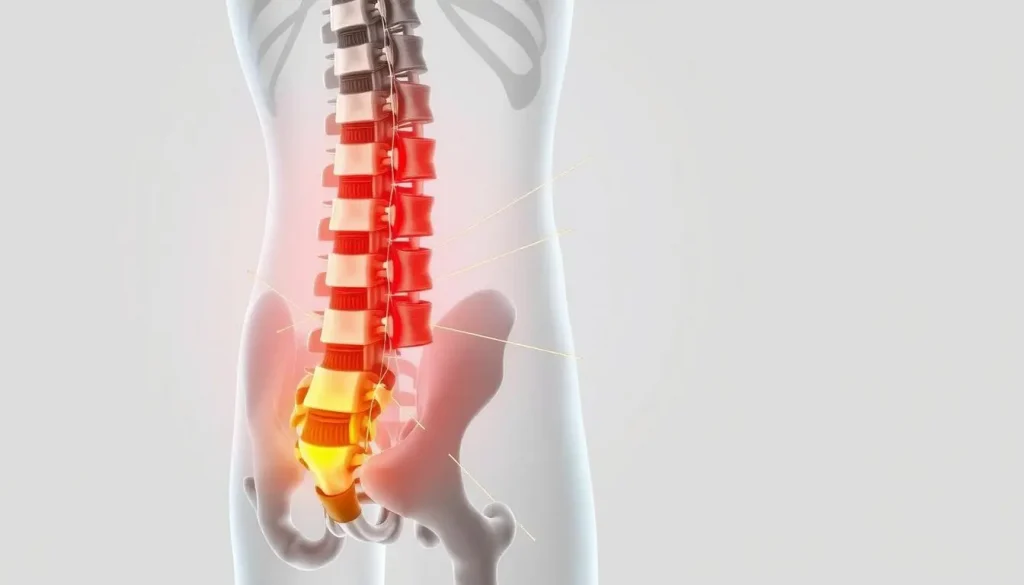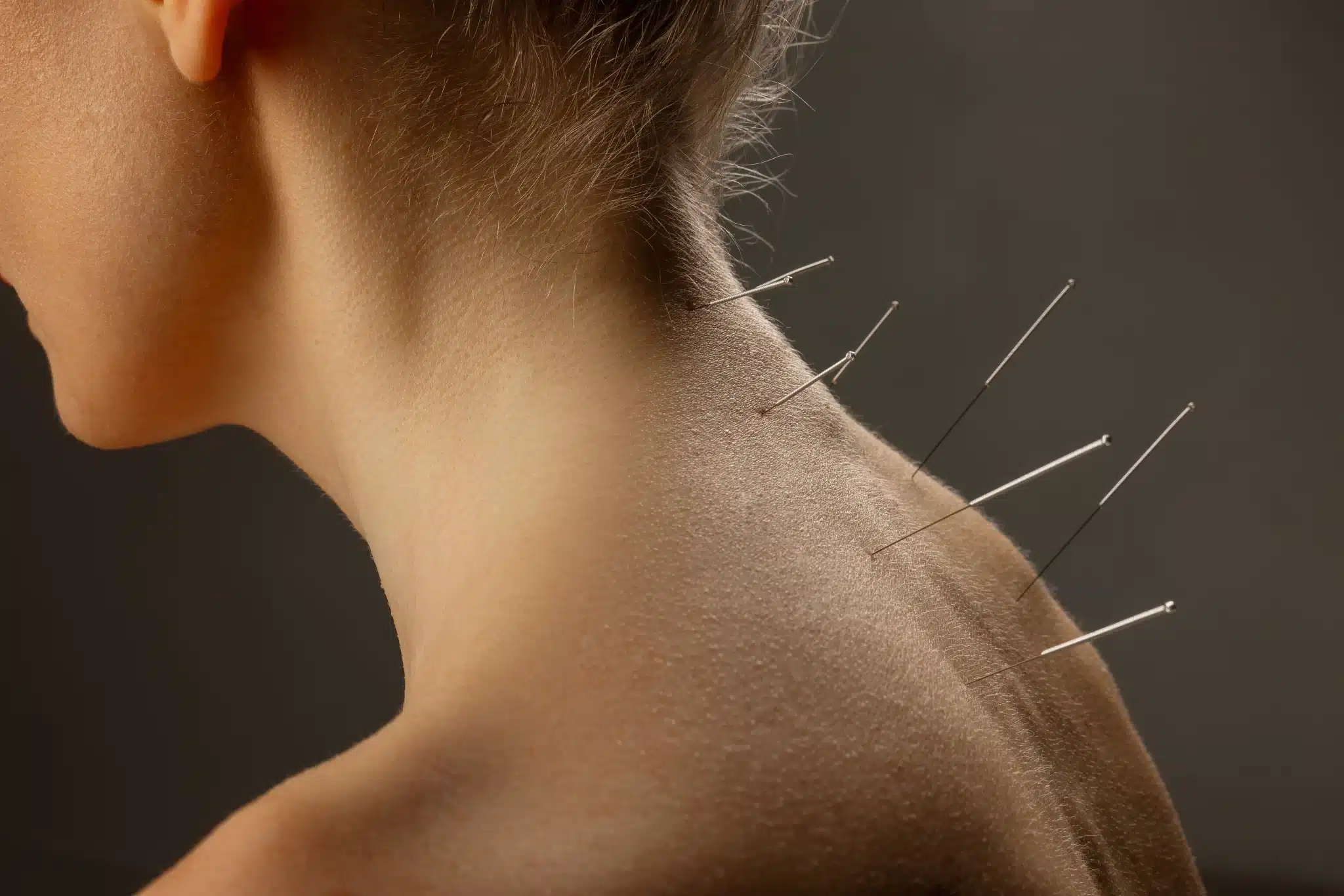Is it just a coincidence or something more serious? Figuring out the cause of lumbar pain can be like solving a puzzle. It's a big problem worldwide, causing disability and costing a lot of money. The code m54.51 shows how common it is, affecting millions of people.
It can hit anyone, from young adults to older folks. The condition is complex, needing a careful look.

A detailed anatomical illustration of the lumbar spine, highlighting areas of pain and discomfort, with emphasis on muscles and nerves, depicted in a medical style. Include visual markers for common causes of lumbar pain, such as herniated discs, sciatica, and muscle strain, all set against a neutral background to enhance focus on the anatomy.
Lumbar pain is not just about simple back problems. It can be linked to many spinal and body conditions. Finding the right cause involves looking at the patient's history, doing physical checks, and sometimes using special scans as part of a thorough lumbar pain differential diagnosis.
It's important to spot warning signs early. This helps find serious problems that need quick medical help.
Key Takeaways
- Lumbar pain is a common and significant health concern, affecting millions and causing substantial disability.
- Proper differential diagnosis is critical for effective back pain management and involves understanding various underlying causes.
- Initial episodes of lumbar pain typically occur between the ages of 20 and 40, with a notable percentage of patients experiencing recurrent or chronic issues.
- Red flag indicators in clinical evaluations are vital for identifying serious conditions requiring urgent care.
- Imaging and diagnostic tests play a complementary role in the lumbar disorders identification process but are not always necessary.
Introduction to Lumbar Pain
The lumbar spine is a key area for chronic low back pain issues. It affects millions globally, making it a big public health problem. We need to understand it well.
Prevalence and Impact
Chronic low back pain hits 50-80% of people at some time. It's the second most common reason for doctor visits, after colds. The HUNT study shows it gets worse with higher body mass indexes.
Gender also affects treatment success. This shows we need different plans for men and women.

A detailed illustration of the lumbar spine anatomy showcasing various conditions, including herniated discs, degenerative disc disease, spinal stenosis, and scoliosis, with an emphasis on the vertebrae and surrounding muscles, nerves, and ligaments in a medical style, labeled parts for clarity, vibrant colors for differentiation.
Worldwide, chronic low back pain is a top cause of disability. It puts a huge strain on healthcare and society. The Global Burden of Disease studies highlight its global impact, including work-related pain. A comprehensive lumbar pain differential diagnosis is crucial to understanding and addressing these widespread issues effectively.
Common Causes of Lumbar Pain
Many things cause lumbar pain, from mechanical issues to systemic conditions. Common mechanical problems include disc herniation and degenerative spondylolisthesis. Spinal stenosis and lumbar radiculopathy are also common.
Behavioral factors like not being active and smoking increase the risk. Kids in sports or smokers are more likely to get sciatica later. This shows why we need to act early to prevent it.
Economic and Social Implications
The cost of lumbar spine conditions is huge. It costs $100 billion a year in healthcare and lost work. It also affects work and social life, adding to the indirect costs.
Common treatments include drugs and exercise for chronic low back pain. This shows we need good ways to manage it.
Clinical Evaluation of Lumbar Pain
Checking lumbar pain is key for right diagnosis and treatment. It includes a full patient check-up, a detailed physical exam, and spotting back pain red flags. A good lumbar medical exam can tell the difference between usual and serious back pain. This helps decide the best treatment, which is listed as ICD code m54.51.
Patient History
Getting a full patient history is the first step. Patients should share when their pain started, where it is, and what it feels like. Important things to ask include:
- Patient's age and overall health.
- Characteristics of the pain (e.g., sharp, dull, or throbbing).
- Medical history, including any previous lumbar medical examination results.
- Aggravating and alleviating factors.
- Presence of symptoms such as numbness or morning stiffness.
A clinical room setting with a focus on a patient undergoing a lumbar examination, featuring a doctor using diagnostic tools like a spinal model and imaging scans, soft lighting, medical charts on the wall, anatomical diagrams depicting the lumbar spine anatomy, and a comfortable examination table.
Physical Examination
The next step is the physical exam. This checks the patient's posture, gait, and the lumbar spine and muscles. It also looks at how much movement is possible and any limitations. Tests like the straight leg raise and reflex exams check nerve roots and other functions.
- Observation of posture and gait.
- Palpation of the lumbar spine.
- Range of motion evaluation.
- Neurological assessments like reflex tests.
Red Flag Indicators
Finding back pain red flags is crucial. These signs include unexplained weight loss, fever, cancer history, or severe nerve problems. Spotting these is important because they might mean a serious issue needs to be looked into right away.
- Unexplained weight loss.
- Fever or chills.
- History of cancer.
- Severe neurological deficits (e.g., bowel or bladder dysfunction).
Looking closely at these points during patient assessment and lumbar medical examination helps find the cause of back pain. This careful method makes sure serious issues are caught early. It helps in treating problems that might be listed as ICD code m54.51.
Mechanical or Intrinsic Spinal Conditions
Mechanical spinal conditions are a big reason for back pain. They affect many people. Discogenic and disc-related pain, and vertebral fractures are key issues. Knowing about these helps doctors diagnose and treat better.
Discogenic and Disc-Related Pain
Discogenic pain comes from inside the discs between vertebrae. It's linked to m54.51, a chronic back pain condition. Finding the exact cause is hard because only 20% of back pain has a clear diagnosis.
Disc-related pain, like from herniated discs, is also common. Tests like the straight leg raise test help diagnose lumbar disc herniation. They show good results in identifying the issue.
Vertebral Pain and Fractures
Vertebral fractures cause a lot of back pain. They can happen from trauma or osteoporosis. About 4% of back pain cases are due to these fractures.
Diagnosing fractures needs X-rays and other imaging. Deep-learning algorithms help too. Osteoporosis, especially in older adults, often leads to these fractures. Lumbar spondylosis affects about 10% of people over 40, showing the wide impact of these conditions.
| Condition | Prevalence | Diagnostic Challenges | Associated Studies |
|---|---|---|---|
| Discogenic Pain | Common | Complex biomechanics, intrinsic disc degeneration | Disc herniation affects 5% to 10% of patients |
| Vertebral Fractures | 4% of low back pain cases | Requires imaging for diagnosis | Osteoporosis as a key factor |
| Lumbar Spondylosis | 10% over age 40 | Associated degenerative processes | Study on lumbar spine injuries in NCAA athletes |
Non-Mechanical or Systemic Conditions
Non-mechanical or systemic lumbar conditions can cause a lot of back pain. These include infections, malignancies, and inflammatory diseases. They can show up in different ways, making it hard to find the exact cause. It's important to understand these conditions to get the right treatment.
Infections and Malignancies
Infectious back pain comes from different sources, like bacteria and viruses. Conditions like osteomyelitis and discitis can cause severe pain. Spinal tumors, whether they're benign or malignant, can also lead to chronic pain.
These tumors can press on nerves and other parts of the spine. Doctors use blood tests, imaging studies, and biopsies to figure out what's going on.
Inflammatory Causes
Inflammatory conditions like ankylosing spondylitis and rheumatoid arthritis can cause a lot of back pain. They make the back stiff and hard to move. Blood tests and MRI scans help doctors diagnose these conditions.
Starting treatment early can help manage these conditions. It can bring relief and improve life quality for those affected.
| Condition | Prevalence | Main Symptoms | Diagnostic Methods | Treatment Approaches |
|---|---|---|---|---|
| Osteomyelitis | ~4/100,000 | Localized pain, fever | MRI, blood tests | Antibiotics, surgery |
| Spinal Tumors | 2-4% of tumors | Severe pain, neurological deficits | MRI, biopsy | Surgery, radiotherapy |
| Ankylosing Spondylitis | 0.1-1.8% | Chronic back pain, stiffness | MRI, blood tests | NSAIDs, physical therapy |
| Rheumatoid Arthritis | 1.3 million Americans | Spinal pain, joint inflammation | Blood tests, X-rays | DMARDs, biologics |
Imaging and Diagnostic Tests for Lumbar Pain Differential Diagnosis
Imaging tests are key to figuring out back pain causes, like m54.51. Back pain is a big reason for doctor visits and emergency room trips in the U.S. Doctors use x-rays, MRI, CT scans, and bone scans to find the root of the problem.
Plain-Film Radiography
X-rays are great for spotting broken bones and arthritis in the lower back. They're a first step in figuring out what's wrong.
Magnetic Resonance Imaging (MRI)
MRI is top for looking at soft tissues in the back. It shows herniated disks, muscle issues, and ligament problems. It's safe because it doesn't use radiation. But, about 60 percent of people without back pain might show disk bulges on an MRI.
Computed Tomographic Scanning (CT)
CT scans give a detailed look at bones. They can spot bone problems, nerve issues, and complex fractures. CT scans use radiation but show bone problems clearly.
Bone Scintigraphy
Bone scans are good for finding bone infections, fractures, and tumors. They're very sensitive to bone activity. This is key for diagnosing back pain causes.
Doctors mix these tests based on what the patient says and what they find. For most back pain, not using these tests right away doesn't help much.
To learn more about patient notes, check out SOAP notes. They help doctors keep good records and improve care.
Conservative Management of Lumbar Pain
Managing lumbar pain without drugs involves many steps. It includes non-drug treatments, medicines, and physical therapy. This approach helps manage pain and improve health without surgery.
Non-Pharmacological Approaches
Non-drug treatments are key for m54.51 pain. Teaching patients about their condition and encouraging them to take part in their care is vital. Activities like yoga, acupuncture, and chiropractic care also help reduce pain and improve function.
Non-drug therapies are important for better health.
Pharmacological Treatments
Medicines are sometimes needed for quick pain relief. Doctors might use analgesics, NSAIDs, or muscle relaxants. But, they should use opioids with care because of the risk of addiction and side effects.
Doctors must carefully choose medicines for each patient. They watch for any bad effects.
Physical Therapy Options
Physical therapy is a big part of treating lumbar pain. It includes manual therapy and exercises to improve movement and strength. Physical therapists create plans for each patient to help them manage pain better.
Going to physical therapy regularly helps a lot in the long run. It helps patients live better with lumbar pain.
| Average Visit Statistics | Percentage |
|---|---|
| Family Physicians | 65.0% |
| Orthopedists | 55.9% |
| Physical Therapists | 50.5% |
| Chiropractors | 46.7% |
In summary, a full plan that includes non-drug treatments, medicines, and physical therapy works well for lumbar pain. It not only relieves pain but also helps patients live better in the long run.
Interprofessional Care for Lumbar Pain
Working together is key in treating lumbar pain. This pain affects many adults, so a team of healthcare providers is needed. They work together to improve patient care and life quality. Conditions like lumbosacral radiculopathy and chronic low back pain need a team effort.
Role of Primary Care Providers
Primary care providers (PCPs) are the first to see patients with lumbar pain. They start with assessments and treatments that don't involve drugs. PCPs also look for signs that need more attention.
Since many adults in the U.S. have low back pain, PCPs are very important. They help diagnose issues like L5 radiculopathy, which is common.
Referral to Specialists
When pain is too complex for PCPs, specialists are needed. Orthopedic surgeons, neurologists, and rheumatologists use advanced tests like MRI and EMG. They handle cases that PCPs can't solve or when serious issues are suspected.
Teamwork between PCPs and specialists is crucial. It ensures patients get the best care for their lumbar pain, especially for chronic or severe cases.
Medicare Finalizes Decision to Cover Acupuncture for Chronic Low Back Pain (M54.51)
FAQ
What is lumbar pain?
Lumbar pain is discomfort in the lower back. It's a big problem that affects many people. It can make daily life hard.
How common is lumbar pain?
Almost all adults will have back pain at some point. It's a top reason for doctor visits.
What are common causes of lumbar pain?
Causes include mechanical issues like disc problems and vertebral fractures. Systemic conditions like infections and cancers also play a role.
What is the economic impact of lumbar pain?
Lumbar pain costs a lot, over $50 billion a year. It also affects work and social life.
How is lumbar pain clinically evaluated?
Doctors look at your history and do a physical check. They consider your age, where the pain is, and what makes it better or worse.
What are red flag indicators of lumbar pain?
Red flags mean you might have a serious problem. Look out for unexplained weight loss, fevers, or cancer history.
What are mechanical spinal conditions that cause lumbar pain?
Mechanical issues include disc problems and fractures. Disc problems come from inside the discs, while fractures can happen from injury or bone thinning.
What systemic conditions can cause lumbar pain?
Systemic issues include infections, cancers, and inflammatory diseases. These can indirectly cause back pain.
What imaging studies are used for lumbar pain diagnosis?
Doctors use X-rays, MRI, CT scans, and bone scans. These help see what's going on in the spine.
What are the conservative management strategies for lumbar pain?
Treatment includes education, exercise, and medicine. Physical therapy is also an option.
What is the role of primary care providers in managing lumbar pain?
Primary care doctors start the treatment. They look for serious cases that need a specialist.
When should a patient be referred to a specialist for lumbar pain?
Refer to specialists if there are red flags or if treatment doesn't work. Specialists like orthopedic surgeons or neurologists can help.
Source Links
- Diagnosis and Treatment of Acute Low Back Pain - https://www.aafp.org/pubs/afp/issues/2012/0215/p343.html
- Causes and Treatment of Lower Back Pain | HSS - https://www.hss.edu/conditions_in-depth-overview-low-back-pain.asp
- Back pain - Symptoms and causes - https://www.mayoclinic.org/diseases-conditions/back-pain/symptoms-causes/syc-20369906
- Mechanical Low Back Pain Differential Diagnoses - https://emedicine.medscape.com/article/310353-differential
- Low Back Pain - Introduction - Spine - https://www.orthobullets.com/spine/2034/low-back-pain--introduction
- Diagnosis and Management of Acute Low Back Pain - https://www.aafp.org/pubs/afp/issues/2000/0315/p1779.html
- Back Pain - StatPearls - NCBI Bookshelf - https://www.ncbi.nlm.nih.gov/books/NBK538173/
- Evaluation of low back pain in adults - https://www.uptodate.com/contents/evaluation-of-low-back-pain-in-adults
- Mechanical Low Back Pain - https://www.aafp.org/pubs/afp/issues/2018/1001/p421.html
- Common differential diagnosis of low back pain in contemporary medical practice: a narrative review - https://www.ncbi.nlm.nih.gov/pmc/articles/PMC10876847/
- Lumbosacral Spine Sprain/Strain Injuries Differential Diagnoses - https://emedicine.medscape.com/article/95444-differential
- Low Back Pain (LBP) and its Mechanical and Non-Mechanical Causes | Cawley Physical Therapy - https://www.cawleypt.net/2022/08/back-pain-mechanical-causes/
- Evaluation of back pain - Differential diagnosis of symptoms - https://bestpractice.bmj.com/topics/en-us/189
- Diagnosing Acute Low Back Pain - https://journalofethics.ama-assn.org/article/diagnosing-acute-low-back-pain/2011-04
- Back pain - Diagnosis and treatment - https://www.mayoclinic.org/diseases-conditions/back-pain/diagnosis-treatment/drc-20369911
- Diagnostic triage for low back pain: a practical approach for primary care - https://www.mja.com.au/system/files/issues/206_06/10.5694mja16.00828.pdf
- Chronic Low Back Pain: Evaluation and Management - https://www.aafp.org/pubs/afp/issues/2009/0615/p1067.html
- Conservative Management of Low Back Pain - https://scholarlycommons.hcahealthcare.com/cgi/viewcontent.cgi?article=1261&context=hcahealthcarejournal
- 7 Ways to Treat Chronic Back Pain Without Surgery - https://www.hopkinsmedicine.org/health/conditions-and-diseases/back-pain/7-ways-to-treat-chronic-back-pain-without-surgery
- Radicular Back Pain - StatPearls - https://www.ncbi.nlm.nih.gov/books/NBK546593/
- Common Questions About Chronic Low Back Pain - https://www.aafp.org/pubs/afp/issues/2015/0515/p708.html
- CEArticle - https://www.nursingcenter.com/cearticle?an=00006205-202308000-00006&Journal_ID=54012&Issue_ID=6739679





